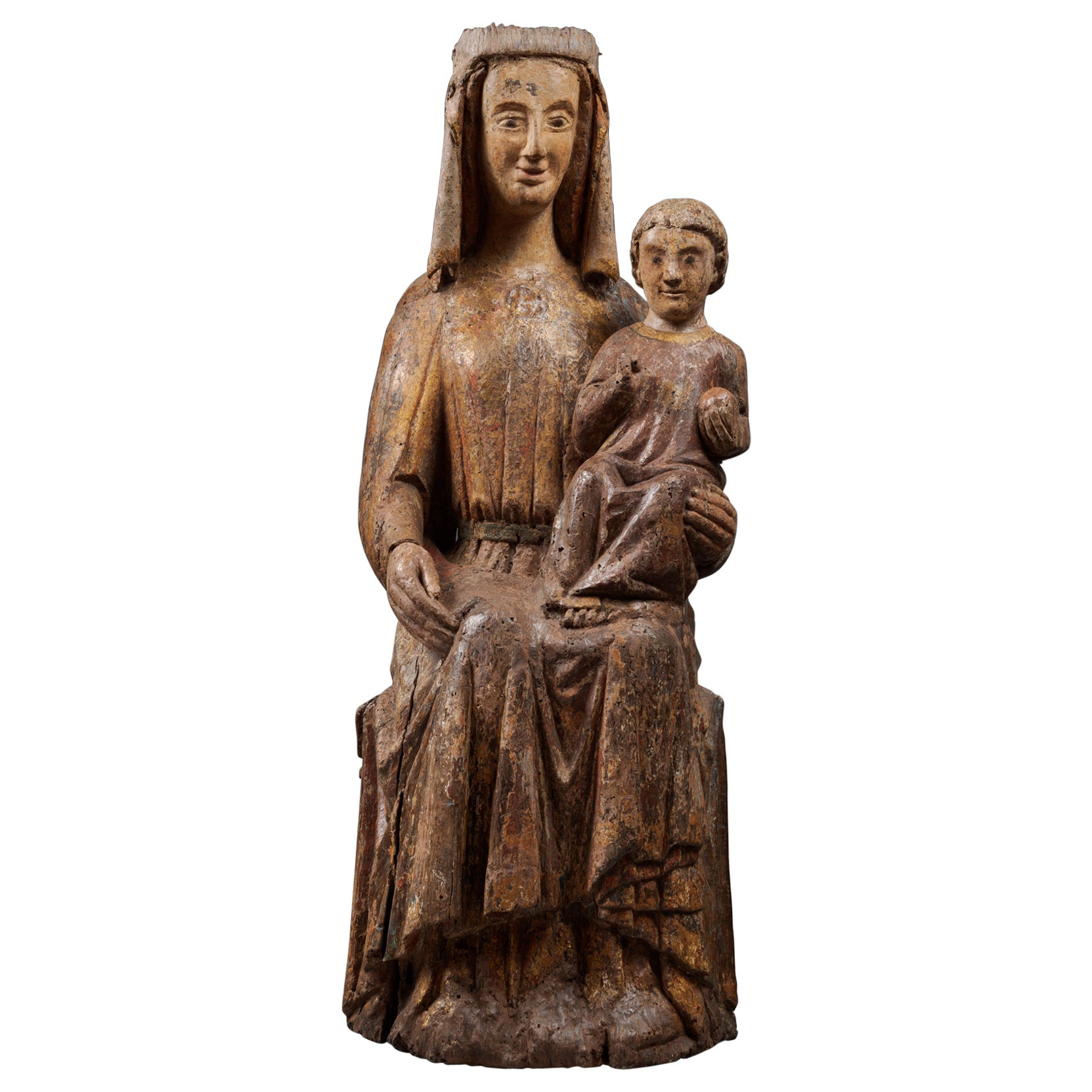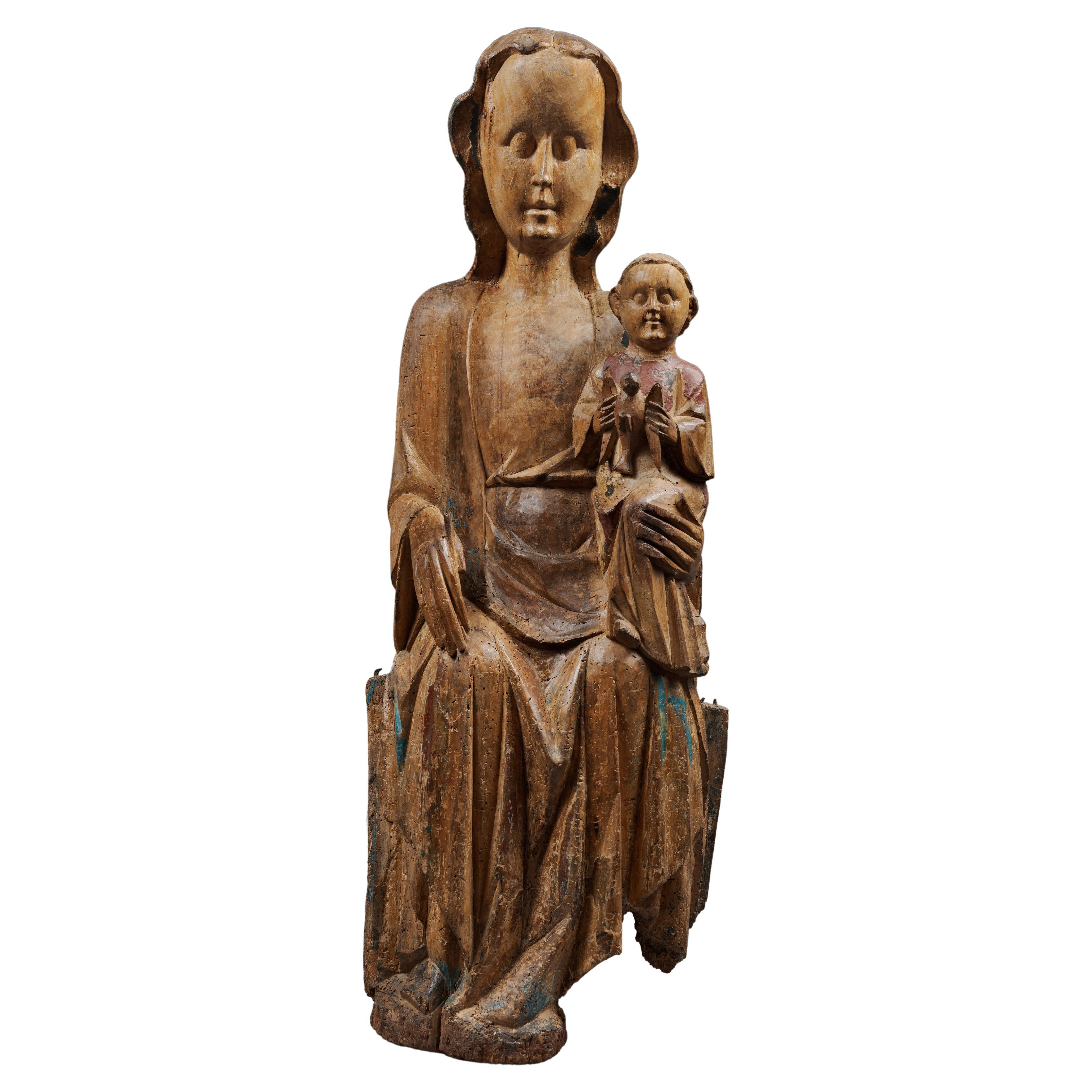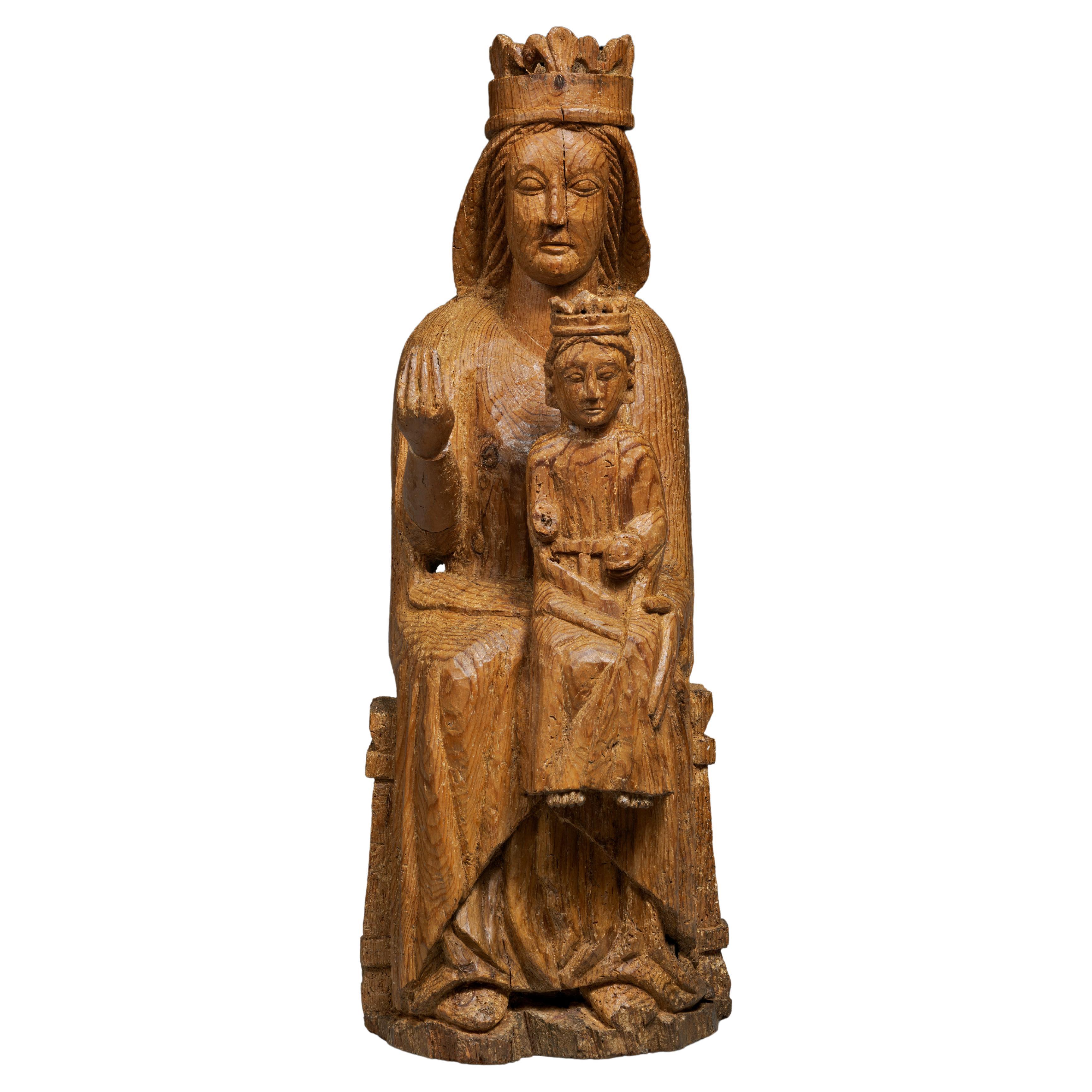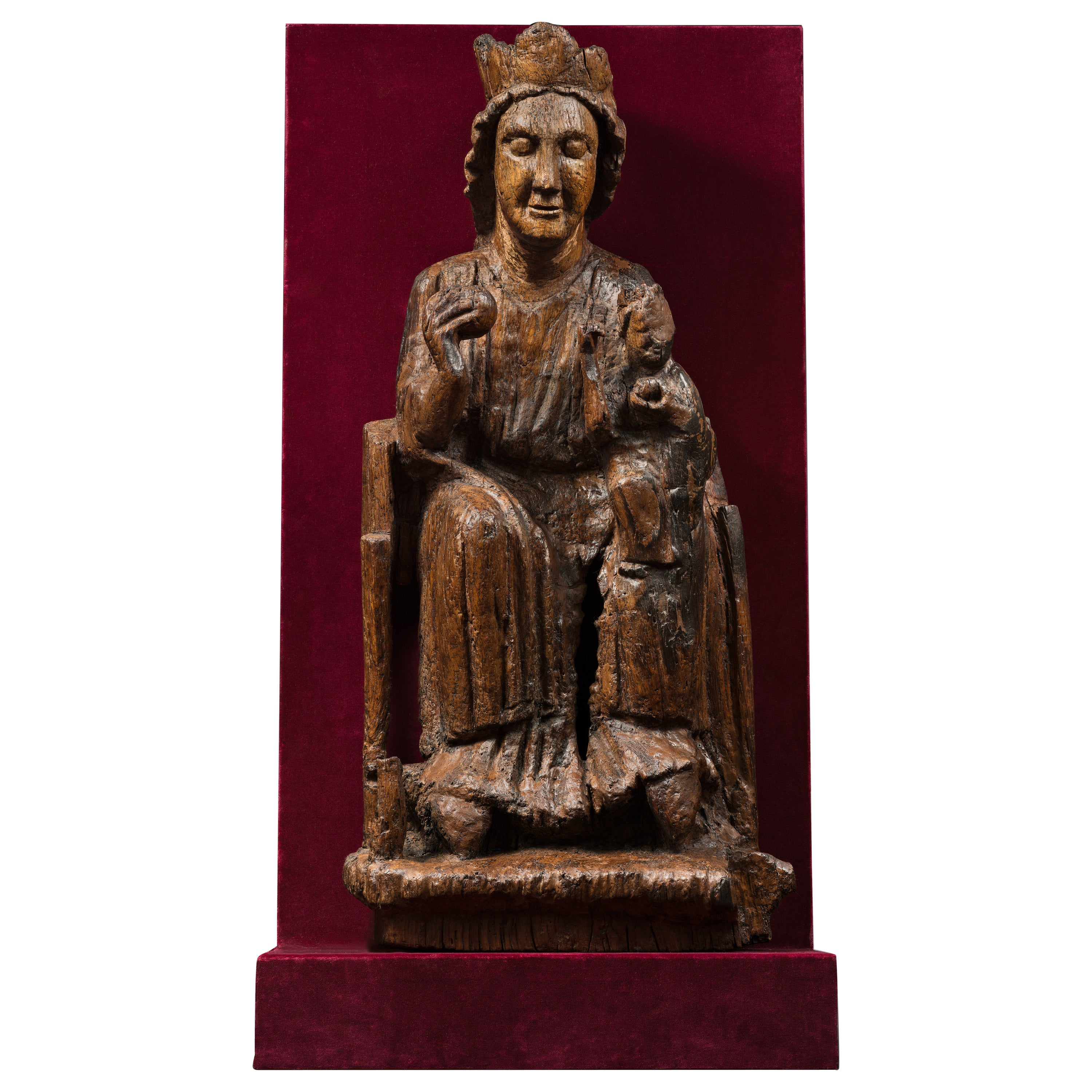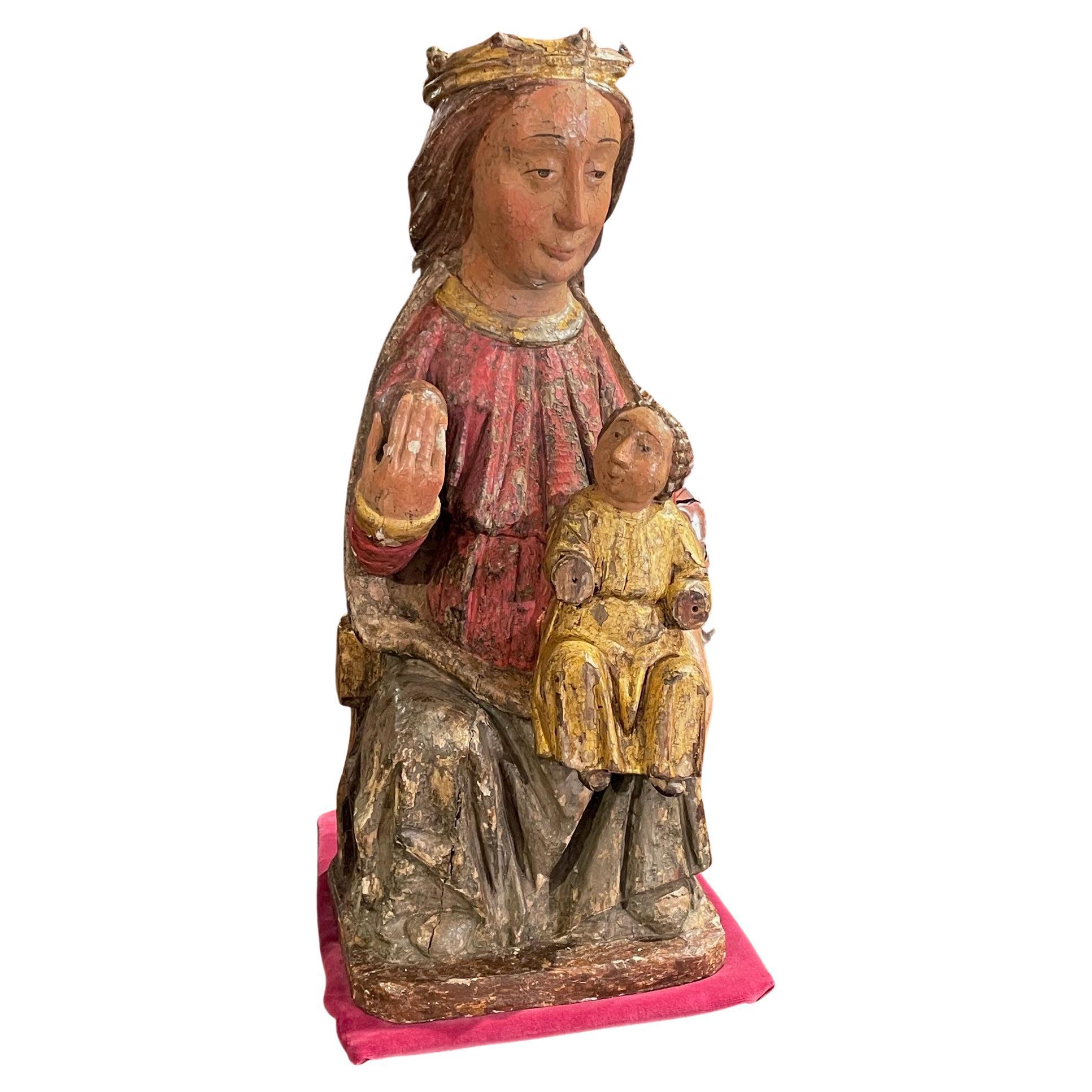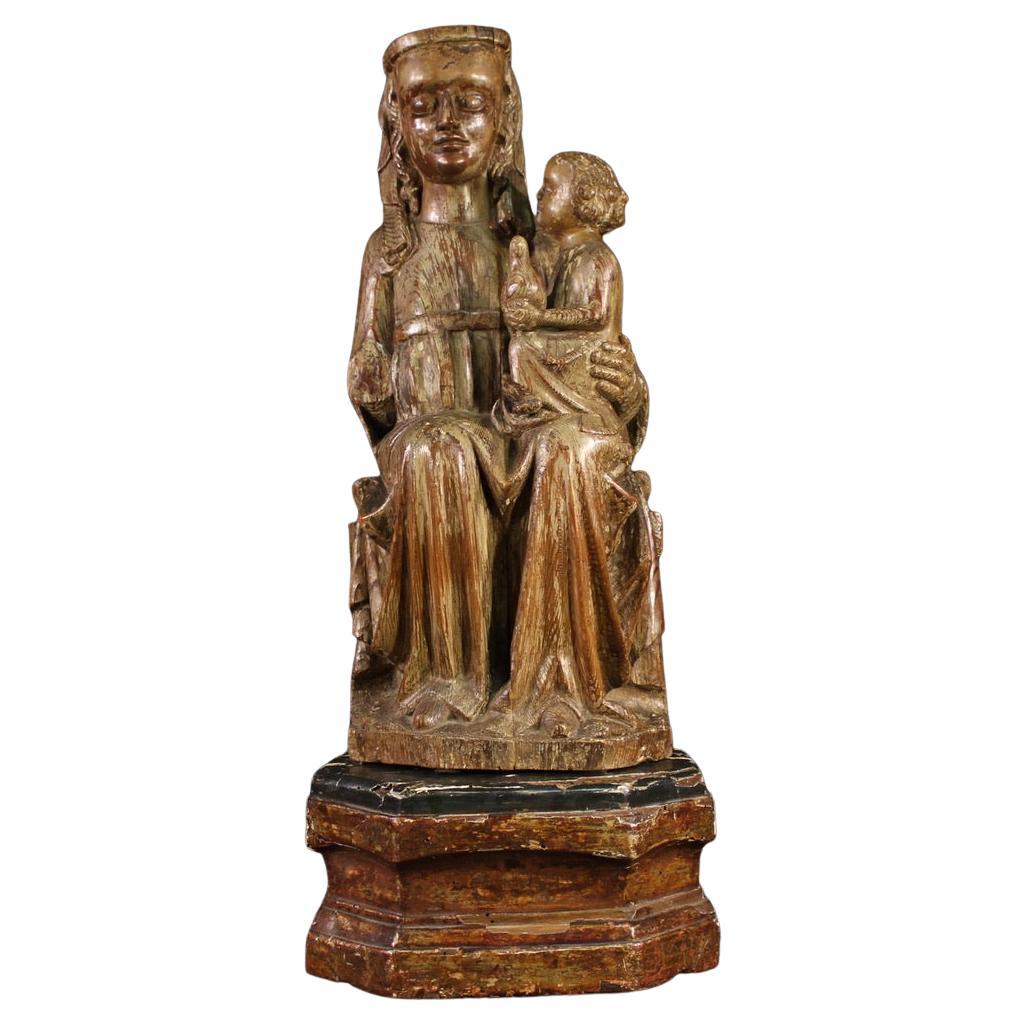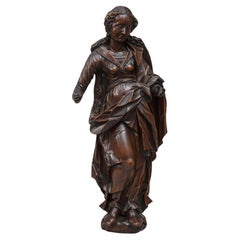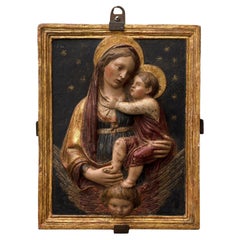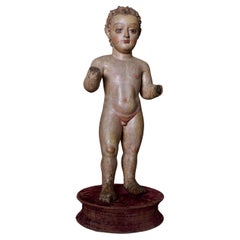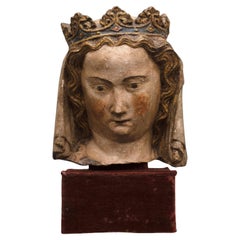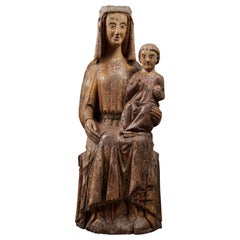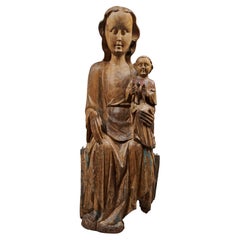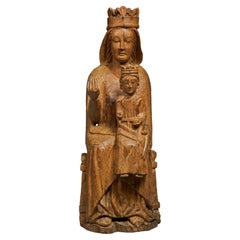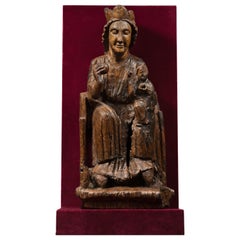Items Similar to Virgin and the Child, Mosan Region, Second Half of 13th Century
Want more images or videos?
Request additional images or videos from the seller
1 of 8
Virgin and the Child, Mosan Region, Second Half of 13th Century
$33,514.71
£24,866.08
€28,000
CA$46,725.04
A$50,659.57
CHF 26,697.49
MX$616,069.80
NOK 332,159.14
SEK 314,111.17
DKK 213,216.43
About the Item
A polychrome sculpture depicting the Virgin and the Child
Mosan region, second half of 13th century
Polychrome wood
73 x 29 X 12 cm
Provenance :
Former Belgian private collection from the beginning of the 20th century
This remarkable early artwork portrays the Enthroned Virgin and Child, also known as Sedes Sapientiae, which translates to the 'Seat of Wisdom' or Throne of Wisdom and specifically alludes to Christ’s both divine and humane nature. Christ is considered as the Divine Wisdom incarnated through Mary (Logos Incarnata); Mary therefore is the bearer (the Throne) of this Divine Wisdom. The base for this theme was laid at the Council of Ephesos in 431 A.D. when Mary was dogmatised as given childbirth to Christ, and titled "Theotokos".
The Sedes sapientiae composition was central to the Marian cult during Romanesque times, with the Virgin appearing in her dual role both as Mother of God and of man, simultaneously presented with Christ seated on Her knee, whilst being enthroned as Queen of Heaven. From the 10th century onwards the "Sedes Sapientiae" emerges as the main –almost only- piece of freestanding sculpture; meaning independent from the architectural iconographic program of the church building. The „Sedes Sapientiae" probably is the idol of medieval Christianity and played an important part in the rural communities; the Sedes mediated between this world and the divine communion of the Saints in all possibly aspects of daily and ecclesial life.
Exquisitely carved, Mary is depicted seated on a throne in a rigid, frontal position, with the Christ Child standing on her left knee. Mary's countenance is directed toward the viewer, with an oblong face and a prominent high forehead. A subtle smile seems to grace her lips, and she wears a short veil, accentuating her delicate and symmetrical features. Her nose is long and straight, and her eyes possess an almond-shaped elegance.
Mary is attired in a tunic that drapes elegantly to just above the ground, with only one of her shoes visible.
While the Virgin appears serene and composed, her son, the Christ Child, exudes a more animated presence, particularly conveyed through the positioning of his feet. He personifies divine wisdom in human form, and his countenance bears an uncanny resemblance to that of a miniature man.
While the composition of the artwork adheres to the rigidity often associated with Romanesque sculpture, this characteristic is intriguingly contrasted by the graceful flow of the drapery and the expressive faces. The drapery, in particular, exhibits a refined quality, convincingly enveloping and revealing the forms beneath. Both Mary and the Christ Child are endowed with subtle, enigmatic smiles.
There are two prominent regions where the „Sedes Sapientiae" was developed and remained popular until the late 13th century: the South/East French / Pyrenean area, with as earliest example the now lost "Madonna of Clermont-Ferrand", dating from ca. 946; and the northern Rhine / Mosan area, with as earliest example the so called "Goldene Madonna" at Essen, dated between 973 and 1050.
This sculpture stands out due to its humanized depiction of the figures and the relative naturalism of the meticulously sculpted drapery. Its heavy drapery with multiple folds, almond-shaped eyes, straight nose, and understated smiles place it within a distinguished category of 'Sedes Sapientiae' sculptures originating from the Mosan region in modern-day Belgium, dating to the late 13th century. Rarely, it preserves traces of original polychromy.
Romanesque wooden sculptures from the 13th century are comparatively rare, especially when contrasted with the greater number of later works. Romanesque wood sculptures from the 13th century are scarce, compared to the healthy number of later ones; this magnificent representation is of high quality and greatest rarity.
- Dimensions:Height: 28.75 in (73 cm)Width: 11.42 in (29 cm)Depth: 4.73 in (12 cm)
- Style:Medieval (Of the Period)
- Materials and Techniques:
- Place of Origin:
- Period:
- Date of Manufacture:13th century
- Condition:Wear consistent with age and use.
- Seller Location:Bruxelles, BE
- Reference Number:1stDibs: LU6666234822652
About the Seller
5.0
Vetted Professional Seller
Every seller passes strict standards for authenticity and reliability
1stDibs seller since 2022
15 sales on 1stDibs
Typical response time: <1 hour
- ShippingRetrieving quote...Shipping from: Bruxelles, Belgium
- Return Policy
Authenticity Guarantee
In the unlikely event there’s an issue with an item’s authenticity, contact us within 1 year for a full refund. DetailsMoney-Back Guarantee
If your item is not as described, is damaged in transit, or does not arrive, contact us within 7 days for a full refund. Details24-Hour Cancellation
You have a 24-hour grace period in which to reconsider your purchase, with no questions asked.Vetted Professional Sellers
Our world-class sellers must adhere to strict standards for service and quality, maintaining the integrity of our listings.Price-Match Guarantee
If you find that a seller listed the same item for a lower price elsewhere, we’ll match it.Trusted Global Delivery
Our best-in-class carrier network provides specialized shipping options worldwide, including custom delivery.More From This Seller
View AllStatuette of the Virgin, South German circa 1600
Located in Bruxelles, BE
Statuette of the Virgin
South-German, circa 1600
sculpted wood
circa 1600
(right arm restored)
52 cm
Category
Antique 17th Century German Renaissance Religious Items
Materials
Wood
Attributed to Domenico di Paris - Madonna and The Child, 15th century
Located in Bruxelles, BE
Attributed to Domenico di Paris, also called Domenico del Cavallo ( Monselice, documented in Ferrara between 1442 and 1501)
Madonna and The Child
Polychromed and gilded Stucco
47,5 ...
Category
Antique 15th Century and Earlier Italian Renaissance Wall-mounted Sculpt...
Materials
Stucco
Child Jesus - Umbria, first half of the 16th century
Located in Bruxelles, BE
Child Jesus
Polychrome and gilded wood
Umbria, first half of the 16th century
H 40 cm
Entirely naked, the Child is standing, leaning on his left leg, his right leg forward; he keep...
Category
Antique 16th Century Italian Renaissance Religious Items
Materials
Wood
Head of a crowned Virgin - Lorraine, first half of 14th century
Located in Bruxelles, BE
Head of a crowned Virgin
Lorraine, first half of 14th century.
H26 x 14 x 14 cm
Provenance :
- Private Collection, Paris France (1960)
Private Collection Tuscany, Italy (1980)
Ex...
Category
Antique 15th Century and Earlier French Gothic Figurative Sculptures
Materials
Limestone
Christ - Umbria, second half of the 15th century
Located in Bruxelles, BE
Christ
Umbria, Orvieto?
Second half of the 15th century
77 x 16.5 cm
Category
Antique 15th Century and Earlier Italian Renaissance Figurative Sculptures
Materials
Walnut
$7,630 Sale Price
25% Off
Followers of Jean de la Huerta, Jean de Blany ? - Saint Jerome
Located in Bruxelles, BE
Followers of Jean de la Huerta, Jean de Blany ?
Saint Jerome
Limestone
Burgundy, second half of the15th century
60,5 cm
ALR Ref : S00248050
This exquisite sculpture of Saint Jerome, carved from soft, nearly white limestone typical of eastern France, exemplifies the exceptional craftsmanship of 15th-century Burgundian art. The figure of Saint Jerome, a key figure in Christian history renowned for translating the Bible into Latin, is depicted wearing a cardinal’s hat and holding the Vulgate Bible...
Category
Antique 15th Century and Earlier French Renaissance Figurative Sculptures
Materials
Limestone
You May Also Like
Important Virgin and Child in Majesty
Located in Saint-Ouen, FR
Important virgin and child in majesty
Origin : Germany Or Eastern France
Époque : Second Half Of The 13th Century
Height: 104.5 cm
Length: 3...
Category
Antique 15th Century and Earlier Figurative Sculptures
Materials
Oak
Virgin and Child in Majesty with a Bird
Located in Saint-Ouen, FR
Virgin and child in majesty with a bird
Origin: Southern Germany Or Austria
Period: Late 13tth - Early 14th Century
Height : 87.5 cm
Length : 32 cm
Depth : 19 cm
Lime ...
Category
Antique 15th Century and Earlier Figurative Sculptures
Materials
Wood
Virgin and Child in Majesty, also known as "Sedes Sapientae"
Located in Saint-Ouen, FR
VIRGIN AND CHILD IN MAJESTY, ALSO KNOWN AS "SEDES SAPIENTIAE"
ORIGIN : SPAIN, CATALOGNE
PERIOD: EARLY 13th CENTURY
Height : 95 cm
Width : 32 cm
Depth : 28 cm
Softwood
No polychromy
In the middle of the 12th century, the Virgin took her place in churches, seated in Majesty, serving as a throne for her son Jesus. She is then called Sedes Sapientiae, meaning the Throne of Wisdom.
At that time, she is not represented for herself and only exists because she has been designated as Theotokos, the mother of God, at the Council of Ephesus in 431, where the divine nature of Christ was proclaimed from his birth.
The upright and perfectly hieratic bust of this Virgin and Child in Majesty is seated on a throne-bench. She is dressed in a tunic with a rounded neckline and covered with a fine mantle placed on her narrow shoulders. The supple and natural drapery follows the lines of the body.
Large curls frame her face with delicate and regular features, a long straight nose, almond-shaped eyes, and small lips.
She supports the Infant Jesus with her left hand. Like his mother, he is dressed in a long tunic, and his little feet are visible in the folds. He holds a small sphere in his left hand, while with his right hand, he gestures in blessing. The face of Christ bears a strong resemblance to his mother’s one, and he gives a slight smile.
The position of the Child is no longer as hieratic, nor frontal or central as in the early 12th century, but his face still turns towards the faithful.
The 13th century indeed emerges as a period of transition in the artistic domain. The statuary, while retaining certain characteristics still belonging to the habits of the previous century, also develops new formal solutions.
As a result, Mary maintains a hieratic and frontal position, while her son shifts to place himself well to the left on her knee. Similarly, while the Virgin seems perfectly still, Jesus, on the other hand, appears much more animated, especially in the positioning of his hands. His left hand holds the orb, and judging by the raised right arm directed towards the faithful, one can easily imagine that he was making a gesture of blessing.
The influence of the Sedes Sapientiae from previous centuries still seems particularly prevalent in this work.
These few characteristics allow dating this Spanish Virgin...
Category
Antique 15th Century and Earlier Spanish Gothic Figurative Sculptures
Materials
Softwood
13th Century Virgin and Child from Catalonia
Located in Saint-Ouen, FR
Seating on a bench-like throne the Virgin carries her child on her left knee.
She bears an important crown high on her head .The Virgin has an ovoid face with bulging eyes, straight long nose and thin lips. The hair parts in the middle and are carved as thick horizontals parallel hair strands...
Category
Antique 15th Century and Earlier Spanish Gothic Figurative Sculptures
Materials
Oak
Virgin and Child in Majesty
Located in Saint-Ouen, FR
Virgin and child in majesty
Origine: castille
Epoque: early 14th century
Measures: Height: 72cm
Length: 30cm
Depth: 25cm
Polychrome and gi...
Category
Antique 15th Century and Earlier Figurative Sculptures
Materials
Wood
$41,893
15th Century Wooden Antique Religious Sculpture Madonna with Child, 1470
Located in Vicoforte, Piedmont
A rare 15th-century religious sculpture. A finely carved wood work depicting the Madonna with Child, likely of Central European origin. Carved from a single block, with a separate, n...
Category
Antique 15th Century and Earlier German Figurative Sculptures
Materials
Wood
More Ways To Browse
13th Century
Virgin And Child
13th Century Furniture
Christ With Child
Medieval Carved Wood
15th Century Polychrome Sculpture
Polychrome Virgin
Bronze Angle
Cherub Cast Bronze
Drinking Sculptures
Fertility Sculptures
French Cherub Bronze Sculpture
Glass Skull
Italian Male Sculpture
Marble Satyr
Mexican Tree
Statue Of David
Terracotta Relief
